Characterizing Spatial and Temporal Variability of Lightning Activity Associated with Wildfire over Tasmania, Australia
Abstract
1. Introduction
2. Data and Methods
2.1. Study Area
2.2. Data
2.2.1. Lightning-Ignited Fire History
2.2.2. Lightning Data
2.2.3. Topographical Characteristics
2.2.4. Vegetation
2.3. Spatial and Temporal Variation of Lightning Strikes
2.4. Lightning Proximity Index Analysis
3. Results
3.1. Spatial Distribution
3.2. Temporal Distribution
3.3. Lightning Flash Polarity and Multiplicity
3.4. Lightning Ignition Candidates
3.5. Lightning Strikes and Land Surface
3.6. Lightning Ignition Efficiency
4. Discussion
5. Conclusions
Supplementary Materials
Author Contributions
Funding
Institutional Review Board Statement
Informed Consent Statement
Data Availability Statement
Acknowledgments
Conflicts of Interest
References
- Bates, B.C.; Chandler, R.E.; Dowdy, A.J. Estimating trends and seasonality in Australian monthly lightning flash counts. J. Geophys. Res. Atmos. 2015, 120, 3973–3983. [Google Scholar] [CrossRef]
- Russell-Smith, J.; Yates, C.P.; Whitehead, P.J.; Smith, R.; Craig, R.; Allan, G.E.; Thackway, R.; Frakes, I.; Cridland, S.; Meyer, M.C. Bushfires ‘down under’: Patterns and implications of contemporary Australian landscape burning. Int. J. Wildland Fire 2007, 16, 361–377. [Google Scholar] [CrossRef]
- Bradstock, R.; Cohn, J.; Gill, A.M.; Bedward, M.; Lucas, C. Prediction of the probability of large fires in the Sydney region of south-eastern Australia using fire weather. Int. J. Wildland Fire 2010, 18, 932–943. [Google Scholar] [CrossRef]
- Sullivan, A.L.; McCaw, W.L.; Cruz, M.G.; Matthews, S.; Ellis, P.F. Fuel, fire weather and fire behaviour in Australian ecosystems. In Flammable Australia: Fire Regimes, Biodiversity and Ecosystems in a Changing World; CSIRO Publishing: Melbourne, Australia, 2012; pp. 51–77. [Google Scholar]
- Dowdy, A.J.; Mills, G.A. Atmospheric States Associated with the Ignition of Lightning-Attributed Fires; Centre for Australian Weather and Climate Research: Melbourne, Australia, 2009. [Google Scholar]
- Wotton, B.; Martell, D.L. A lightning fire occurrence model for Ontario. Can. J. For. Res. 2005, 35, 1389–1401. [Google Scholar] [CrossRef]
- Conedera, M.; Cesti, G.; Pezzatti, G.B.; Zumbrunnen, T.; Spinedi, F. Lightning-induced fires in the Alpine region: An increasing problem. For. Ecol. Manag. 2006, 234, S68. [Google Scholar] [CrossRef]
- Dowdy, A.J.; Mills, G.A. Characteristics of lightning-attributed wildland fires in south-east Australia. Int. J. Wildland Fire 2012, 21, 521–524. [Google Scholar] [CrossRef]
- Vázquez, A.; Moreno, J.M. Patterns of lightning-, and people-caused fires in peninsular Spain. Int. J. Wildland Fire 1998, 8, 103–115. [Google Scholar] [CrossRef]
- Wendler, G.; Conner, J.; Moore, B.; Shulski, M.; Stuefer, M. Climatology of Alaskan wildfires with special emphasis on the extreme year of 2004. Theor. Appl. Climatol. 2011, 104, 459–472. [Google Scholar] [CrossRef]
- Bowman, D.M.; Balch, J.K.; Artaxo, P.; Bond, W.J.; Carlson, J.M.; Cochrane, M.A.; D’Antonio, C.M.; DeFries, R.S.; Doyle, J.C.; Harrison, S.P. Fire in the Earth system. Science 2009, 324, 481–484. [Google Scholar] [CrossRef]
- Taylor, S.W.; Woolford, D.G.; Dean, C.; Martell, D.L. Wildfire prediction to inform management: Statistical science challenges. Stat. Sci. 2013, 586–615. [Google Scholar] [CrossRef]
- Blouin, K.D.; Flannigan, M.D.; Wang, X.; Kochtubajda, B. Ensemble lightning prediction models for the province of Alberta, Canada. Int. J. Wildland Fire 2016, 25, 421–432. [Google Scholar] [CrossRef]
- Price, C. Thunderstorms lightning and climate change. In Lightning Principles, Instruments and Applications: Review of Modern Lightning Research; Betz, H.D., Schumann, U., Laroche, P., Eds.; Springer: Dordrecht, The Netherlands, 2009. [Google Scholar]
- Rakov, V.A.; Uman, M.A. Lightning: Physics and Effects; Cambridge University Press: Cambridge, UK, 2003. [Google Scholar]
- Price, C.; Rind, D. The impact of a 2× CO2 climate on lightning-caused fires. J. Clim. 1994, 7, 1484–1494. [Google Scholar] [CrossRef]
- Price, C. Possible implications of global climate change on global lightning distributions and frequencies. J. Geophys. Res. Atmos. 1994, 99, 10823–10831. [Google Scholar] [CrossRef]
- Krause, A. The sensitivity of global wildfires to simulated past, present, and future lightning frequency. J Geophys. Res. Biogeosci. 2014, 119, 312–322. [Google Scholar] [CrossRef]
- Williams, E. Lightning and climate: A review. Atmos. Res. 2005, 76, 272–287. [Google Scholar] [CrossRef]
- Romps, D.M.; Seeley, J.T.; Vollaro, D.; Molinari, J. Projected increase in lightning strikes in the United States due to global warming. Science 2014, 346, 851–854. [Google Scholar] [CrossRef] [PubMed]
- Price, C. Thunderstorms, lightning and climate change. In Lightning: Principles, Instruments and Applications; Springer: Berlin/Heidelberg, Germany, 2009; pp. 521–535. [Google Scholar]
- Romatschke, U.; Houze Jr, R.A. Characteristics of precipitating convective systems in the South Asian monsoon. J. Hydrometeorol. 2011, 12, 3–26. [Google Scholar] [CrossRef]
- Barros, A.P.; Chiao, S.; Lang, T.J.; Burbank, D.; Putkonen, J. From weather to climate-seasonal and interannual variability of storms and implications for erosion processes in the Himalaya. Spec. Pap. Geol. Soc. Am. 2006, 398, 17. [Google Scholar]
- Kodama, Y.M.; Ohta, A.; Katsumata, M.; Mori, S.; Satoh, S.; Ueda, H. Seasonal transition of predominant precipitation type and lightning activity over tropical monsoon areas derived from TRMM observations. Geophys. Res. Lett. 2005, 32. [Google Scholar] [CrossRef]
- Krawchuk, M.A. Burning issues: Statistical analyses of global fire data to inform assessments of environmental change. Environmetrics 2014, 25, 472–481. [Google Scholar] [CrossRef]
- Fauria, M.M. Predicting climate change effects on wildfires requires linking processes across scales. Wiley Interdiscip. Rev. Clim. 2011, 2, 99–112. [Google Scholar] [CrossRef]
- Potter, B.E. Atmospheric interactions with wildland fire behaviour—I. Basic surface interactions, vertical profiles and synoptic structures. Int. J. Wildland Fire 2012, 21, 779–801. [Google Scholar] [CrossRef]
- Potter, B.E. Atmospheric interactions with wildland fire behaviour—II. Plume and vortex dynamics. Int. J. Wildland Fire 2012, 21, 802–817. [Google Scholar] [CrossRef]
- Fox-Hughes, P.; Harris, R.; Lee, G.; Grose, M.; Bindoff, N. Future fire danger climatology for Tasmania, Australia, using a dynamically downscaled regional climate model. Int. J. Wildland Fire 2014, 23, 309–321. [Google Scholar] [CrossRef]
- Clarke, H.; Gibson, R.; Cirulis, B.; Bradstock, R.A.; Penman, T.D. Developing and testing models of the drivers of anthropogenic and lightning-caused wildfire ignitions in south-eastern Australia. J. Environ. Manag. 2019, 235, 34–41. [Google Scholar] [CrossRef]
- Cai, W.; Sullivan, A.; Cowan, T. Climate change contributes to more frequent consecutive positive Indian Ocean Dipole events. Geophys. Res. Lett. 2009, 36. [Google Scholar] [CrossRef]
- Clarke, H.; Evans, J.P. Exploring the future change space for fire weather in southeast Australia. Theor. Appl. Climatol. 2019, 136, 513–527. [Google Scholar] [CrossRef]
- Clarke, H.; Lucas, C.; Smith, P. Changes in Australian fire weather between 1973 and 2010. Int. J. Climatol. 2013, 33, 931–944. [Google Scholar] [CrossRef]
- Abatzoglou, J.; Williams, A. Climate change has added to western US forest fire. Proc. Natl. Acad. Sci. USA 2016, 113, 11770–11775. [Google Scholar] [CrossRef]
- Dowdy, A.J. Climatological Variability of Fire Weather in Australia. J. Appl. Meteorol. Climatol. 2018, 57, 221–234. [Google Scholar] [CrossRef]
- Pitman, A.J.; Narisma, G.T.; McAneney, J. The impact of climate change on the risk of forest and grassland fires in Australia. Clim. Chang. 2007, 84, 383–401. [Google Scholar] [CrossRef]
- Dowdy, A.J.; Ye, H.; Pepler, A.; Thatcher, M.; Osbrough, S.L.; Evans, J.P.; Di Virgilio, G.; McCarthy, N. Future changes in extreme weather and pyroconvection risk factors for Australian wildfires. Sci. Rep. 2019, 9, 10073. [Google Scholar] [CrossRef]
- Müller, M.M.; Vacik, H.; Diendorfer, G.; Arpaci, A.; Formayer, H.; Gossow, H. Analysis of lightning-induced forest fires in Austria. Theor. Appl. Climatol. 2013, 111, 183–193. [Google Scholar] [CrossRef]
- Pineda, N.; Montanyà, J.; van der Velde, O.A. Characteristics of lightning related to wildfire ignitions in Catalonia. Atmos. Res. 2014, 135–136, 380–387. [Google Scholar] [CrossRef]
- Pineda, N.; Rigo, T. The rainfall factor in lightning-ignited wildfires in Catalonia. Agric. For. Meteorol. 2017, 239, 249–263. [Google Scholar] [CrossRef]
- Wierzchowski, J.; Heathcott, M.; Flannigan, M.D. Lightning and lightning fire, central cordillera, Canada. Int. J. Wildland Fire 2002, 11, 41–51. [Google Scholar] [CrossRef]
- Larjavaara, M.; Kuuluvainen, T.; Rita, H. Spatial distribution of lightning-ignited forest fires in Finland. For. Ecol. Manag. 2005, 208, 177–188. [Google Scholar] [CrossRef]
- Schulz, W.; Diendorfer, G.; Pedeboy, S.; Poelman, D.R. The European lightning location system EUCLID—Part 1: Performance analysis and validation. Nat. Hazards Earth Syst. Sci. 2016, 16, 595–605. [Google Scholar] [CrossRef]
- Bentley, M.L.; Stallins, J. Climatology of cloud-to-ground lightning in Georgia, USA, 1992–2003. Int. J. Climatol. 2005, 25, 1979–1996. [Google Scholar] [CrossRef]
- Peterson, D.; Wang, J.; Ichoku, C.; Remer, L. Effects of lightning and other meteorological factors on fire activity in the North American boreal forest: Implications for fire weather forecasting. Atmos. Chem. Phys. 2010, 10, 6873–6888. [Google Scholar] [CrossRef]
- Lang, T.J.; Rutledge, S.A. Cloud-to-ground lightning downwind of the 2002 Hayman forest fire in Colorado. Geophys. Res. Lett. 2006, 33. [Google Scholar] [CrossRef]
- Arabas, K.B.; Hadley, K.S.; Larson, E.R. Fire history of a naturally fragmented landscape in central Oregon. Can. J. For. Res. 2006, 36, 1108–1120. [Google Scholar] [CrossRef]
- Van Wagtendonk, J.W.; Cayan, D.R. Temporal and spatial distribution of lightning strikes in California in relation to large-scale weather patterns. Fire Ecol. 2008, 4, 34–56. [Google Scholar] [CrossRef]
- Morissette, J.; Gauthier, S. Study of cloud-to-ground lightning in Quebec: 1996–2005. Atmosphere-Ocean 2008, 46, 443–454. [Google Scholar] [CrossRef]
- Kochtubajda, B.; Burrows, W.R. A decade of cloud-to-ground lightning in Canada: 1999–2008. Part 2: Polarity, multiplicity and first-stroke peak current. Atmosphere-Ocean 2010, 48, 195–209. [Google Scholar] [CrossRef]
- Burrows, W.R.; Kochtubajda, B. A decade of cloud-to-ground lightning in Canada: 1999–2008. Part 1: Flash density and occurrence. Atmosphere-Ocean 2010, 48, 177–194. [Google Scholar] [CrossRef]
- Soriano, L.R.; De Pablo, F.; Tomas, C. Ten-year study of cloud-to-ground lightning activity in the Iberian Peninsula. J. Atmos. Sol.-Terr. Phys. 2005, 67, 1632–1639. [Google Scholar] [CrossRef]
- Antonescu, B.; Burcea, S. A cloud-to-ground lightning climatology for Romania. Mon. Weather Rev. 2010, 138, 579–591. [Google Scholar] [CrossRef]
- Schulz, W.; Cummins, K.; Diendorfer, G.; Dorninger, M. Cloud-to-ground lightning in Austria: A 10-year study using data from a lightning location system. J. Geophys. Res. Atmos. 2005, 110. [Google Scholar] [CrossRef]
- Sonnadara, U.; Cooray, V.; Götschl, T. Characteristics of cloud-to-ground lightning flashes over Sweden. Phys. Scr. 2006, 74, 541–548. [Google Scholar] [CrossRef]
- Mäkelä, J.S.; Porjo, N.; Mäkelä, A.; Tuomi, T.; Cooray, V. Properties of preliminary breakdown processes in Scandinavian lightning. J. Atmos. Sol.-Terr. Phys. 2008, 70, 2041–2052. [Google Scholar] [CrossRef]
- Novák, P.; Kyznarová, H. Climatology of lightning in the Czech Republic. Atmos. Res. 2011, 100, 318–333. [Google Scholar] [CrossRef]
- Santos, J.; Reis, M.; Sousa, J.; Leite, S.; Correia, S.; Janeira, M.; Fragoso, M. Cloud-to-ground lightning in Portugal: Patterns and dynamical forcing. Nat. Hazards Earth Syst. Sci. 2012, 12, 639–649. [Google Scholar] [CrossRef]
- Ramos, A.M.; Ramos, R.; Sousa, P.; Trigo, R.M.; Janeira, M.; Prior, V. Cloud to ground lightning activity over Portugal and its association with circulation weather types. Atmos. Res. 2011, 101, 84–101. [Google Scholar] [CrossRef]
- Royé, D.; Lorenzo, N.; Martin-Vide, J. Spatial–temporal patterns of cloud-to-ground lightning over the northwest Iberian Peninsula during the period 2010–2015. Nat. Hazards 2018, 92, 857–884. [Google Scholar] [CrossRef]
- Giannaros, T.M.; Kotroni, V.; Lagouvardos, K. Predicting lightning activity in Greece with the Weather Research and Forecasting (WRF) model. Atmos. Res. 2015, 156, 1–13. [Google Scholar] [CrossRef]
- Matsangouras, I.; Nastos, P.; Kapsomenakis, J. Cloud-to-ground lightning activity over Greece: Spatio-temporal analysis and impacts. Atmos. Res. 2016, 169, 485–496. [Google Scholar] [CrossRef]
- Chronis, T.G. Preliminary lightning observations over Greece. J. Geophys. Res. Atmos. 2012, 117. [Google Scholar] [CrossRef]
- Galanaki, E.; Kotroni, V.; Lagouvardos, K.; Argiriou, A. A ten-year analysis of cloud-to-ground lightning activity over the Eastern Mediterranean region. Atmos. Res. 2015, 166, 213–222. [Google Scholar] [CrossRef]
- Nastos, P.; Matsangouras, I.; Chronis, T. Spatio-temporal analysis of lightning activity over Greece—Preliminary results derived from the recent state precision lightning network. Atmos. Res. 2014, 144, 207–217. [Google Scholar] [CrossRef]
- Kilinc, M.; Beringer, J. The spatial and temporal distribution of lightning strikes and their relationship with vegetation type, elevation, and fire scars in the Northern Territory. J. Clim. 2007, 20, 1161–1173. [Google Scholar] [CrossRef]
- Podur, J.; Martell, D.L.; Csillag, F. Spatial patterns of lightning-caused forest fires in Ontario, 1976–1998. Ecol. Model. 2003, 164, 1–20. [Google Scholar] [CrossRef]
- Abatzoglou, J.T.; Kolden, C.A.; Balch, J.K.; Bradley, B.A. Controls on interannual variability in lightning-caused fire activity in the western US. Environ. Res. Lett 2016, 11, 045005. [Google Scholar] [CrossRef]
- Hall, B.L. Precipitation associated with lightning-ignited wildfires in Arizona and New Mexico. Int. J. Wildland Fire 2007, 16, 242–254. [Google Scholar] [CrossRef]
- Fuquay, D.M. Mountain thunderstorms and forest fires. Weatherwise 1962, 15, 149–152. [Google Scholar] [CrossRef]
- Latham, D.; Williams, E. Lightning and forest fires. In Forest Fires; Elsevier: Amsterdam, The Netherlands, 2001; pp. 375–418. [Google Scholar]
- Price, C.; Rind, D. What determines the cloud-to-ground lightning fraction in thunderstorms? Geophys. Res. Lett. 1993, 20, 463–466. [Google Scholar] [CrossRef]
- Hall, B.L.; Brown, T.J. Climatology of positive polarity flashes and multiplicity and their relation to natural wildfire ignitions. In Proceedings of the 19th International lightning DETECTION Conference, Tucson, AZ, USA, 24–25 April 2006. [Google Scholar]
- Flannigan, M.; Wotton, B. Lightning-ignited forest fires in northwestern Ontario. Can. J. For. Res. 1991, 21, 277–287. [Google Scholar] [CrossRef]
- Anderson, K. A model to predict lightning-caused fire occurrences. Int. J. Wildland Fire 2002, 11, 163–172. [Google Scholar] [CrossRef]
- Schumann, C.; Saba, M.M.F.; Da Silva, R.B.G.; Schulz, W. Electric fields changes produced by positives cloud-to-ground lightning flashes. J. Atmos. Sol.-Terr. Phys. 2013, 92, 37–42. [Google Scholar] [CrossRef]
- Saba, M.M.; Schulz, W.; Warner, T.A.; Campos, L.Z.; Schumann, C.; Krider, E.P.; Cummins, K.L.; Orville, R.E. High-speed video observations of positive lightning flashes to ground. J. Geophys. Res. Atmos. 2010, 115. [Google Scholar] [CrossRef]
- Fuquay, D.M.; Taylor, A.R.; Hawe, R.G.; Schmid Jr., C.W. Lightning discharges that caused forest fires. J. Geophys. Res. 1972, 77, 2156–2158. [Google Scholar] [CrossRef]
- Saba, M.; Pinto, O., Jr.; Ballarotti, M. Relation between lightning return stroke peak current and following continuing current. Geophys. Res. Lett. 2006, 33. [Google Scholar] [CrossRef]
- Fuquay, D.M. Positive cloud-to-ground lightning in summer thunderstorms. J. Geophys. Res. Oceans. 1982, 87, 7131–7140. [Google Scholar] [CrossRef]
- Kuleshov, Y.; Hettrick, P.; Mackerras, D.; Darveniza, M.; Jayaratne, E. Occurrence of positive and negative polarity cloud-to-ground lightning flashes: Case study of CGR4 and GPATS data for Brisbane, Australia. Aust. Meteorol. Oceanogr. J. 2011, 61, 107. [Google Scholar] [CrossRef]
- Mills, G.A. A re-examination of the synoptic and mesoscale meteorology of Ash Wednesday 1983. Aust. Meteorol. Mag. 2005, 54, 35–55. [Google Scholar]
- Mills, G.A. On the sub-synoptic scale meteorology of two extreme fire weather days during the Eastern Australian fires of January 2003. Aust. Met. Mag 2005, 54, 265–290. [Google Scholar]
- Bond, H.G. Report on the Meteorological Aspects of the Catastrophic Bushfires in South-Eastern Tasmania; Bond, H.G., Mackinnon, K., Noar, P.F., Eds.; Bureau of Meteorology: Melbourne, Australia, 1967. [Google Scholar]
- Fletcher, M.S.; Wolfe, B.B.; Whitlock, C.; Pompeani, D.P.; Heijnis, H.; Haberle, S.G.; Gadd, P.S.; Bowman, D.M. The legacy of mid-Holocene fire on a Tasmanian montane landscape. J. Biogeogr. 2014, 41, 476–488. [Google Scholar] [CrossRef]
- Holz, A.; Wood, S.W.; Veblen, T.T.; Bowman, D.M. Effects of high-severity fire drove the population collapse of the subalpine Tasmanian endemic conifer Athrotaxis cupressoides. Glob. Chang. Biol. 2015, 21, 445–458. [Google Scholar] [CrossRef]
- Marsden-Smedley, J.B.; Kirkpatrick, J.B. Fire management in Tasmania’s wilderness world heritage area: Ecosystem restoration using indigenous-style fire regimes? Ecol. Manag. Restor. 2000, 1, 195–203. [Google Scholar] [CrossRef]
- Kuleshov, Y.; De Hoedt, G.; Wright, W.; Brewster, A. Thunderstorm distribution and frequency in Australia. Aust. Meteorol. Mag. 2002, 51, 145. [Google Scholar]
- Australasian Fire and Emergency Service Authorities Council. AFAC Independent Operational Review: A Review of the Management of the Tasmanian Fires of December 2018–March 2019. Available online: http://www.fire.tas.gov.au/userfiles/AFAC/AFAC_Review.pdf (accessed on 1 March 2020).
- Styger, J.; Marsden-Smedley, J.; Kirkpatrick, J. Changes in lightning fire incidence in the Tasmanian wilderness world heritage area, 1980–2016. Fire 2018, 1, 38. [Google Scholar] [CrossRef]
- Earl, N.; Love, P.; Harris, R.; Remenyi, T. Dry Lightning Has Set Tasmania Ablaze and Climate Change Make It More Likely to Happen Again. Available online: https://theconversation.com/dry-lightning-has-set-tasmania-ablaze-and-climate-changemakes-itmore-likely-to-happen-again-111264 (accessed on 7 February 2019).
- Cummins, K.L.; Murphy, M.J. An overview of lightning locating systems: History, techniques, and data uses, with an in-depth look at the US NLDN. IEEE Trans. Electromagn. Compat. 2009, 51, 499–518. [Google Scholar] [CrossRef]
- Dowdy, A.J.; Fromm, M.D.; McCarthy, N. Pyrocumulonimbus lightning and fire ignition on Black Saturday in southeast Australia. J. Geophys. Res. Atmos. 2017, 122, 7342–7354. [Google Scholar] [CrossRef]
- MacNamara, B.R.; Schultz, C.J.; Fuelberg, H.E. Flash Characteristics and Precipitation Metrics of Western US Lightning-Initiated Wildfires from 2017. Fire 2020, 3, 5. [Google Scholar] [CrossRef]
- Richard, P.; Lojou, J. Assessment of application of storm cell electrical activity monitoring to intense precipitation forecast. In Proceedings of the 10th Conference on Atmospheric Electricity, Osaka, Japan, 10–14 June 1996; pp. 10–14. [Google Scholar]
- Dowdy, A.J.; Mills, G.A. Atmospheric and fuel moisture characteristics associated with lightning-attributed fires. J. Appl. Meteorol. Clim. 2012, 51, 2025–2037. [Google Scholar] [CrossRef]
- Dissing, D.; Verbyla, D.L. Spatial patterns of lightning strikes in interior Alaska and their relations to elevation and vegetation. Can. J. For. Res. 2003, 33, 770–782. [Google Scholar] [CrossRef]
- Albrecht, R.I.; Goodman, S.J.; Buechler, D.E.; Blakeslee, R.J.; Christian, H.J. Where are the lightning hotspots on Earth? Bull. Am. Meteorol. Soc. 2016, 97, 2051–2068. [Google Scholar] [CrossRef]
- Weiss, A. Topographic position and landforms analysis. In Proceedings of Poster presentation. In Proceedings of the ESRI User Conference, San Diego, CA, USA, 9–13 July 2001. [Google Scholar]
- Zhou, S.; Chen, G.; Fang, L.; Nie, Y. GIS-based integration of subjective and objective weighting methods for regional landslides susceptibility mapping. Sustainability 2016, 8, 334. [Google Scholar] [CrossRef]
- Tasmanian Department of Primary Industries, Parks, Water and Environment. Tasmanian Vegetation Monitoring and Mapping Program; TASVEG 3.0; Resource Management and Conservation Division, Department of Primary Industries, Parks, Water and Environment: Hobart, Australia, 2013. [Google Scholar]
- Hernandez-Magallanes, I.; Genton, M.G. A point process analysis of cloud-to-ground lightning strikes in urban and rural Oklahoma areas. Environmetrics 2019, 30, e2535. [Google Scholar] [CrossRef]
- Moris, J.V.; Conedera, M.; Nisi, L.; Bernardi, M.; Cesti, G.; Pezzatti, G.B. Lightning-caused fires in the Alps: Identifying the igniting strokes. Agric. For. Meteorol. 2020, 290, 107990. [Google Scholar] [CrossRef]
- McRae, R.H. Prediction of areas prone to lightning ignition. Int. J. Wildland Fire 1992, 2, 123–130. [Google Scholar] [CrossRef]
- Kuleshov, Y.; Jayaratne, E. Estimates of lightning ground flash density in Australia and its relationship to thunder-days. Aust. Meteorol. Mag. 2004, 53, 189–196. [Google Scholar]
- Blakeslee, R.J.; Mach, D.M.; Bateman, M.G.; Bailey, J.C. Seasonal variations in the lightning diurnal cycle and implications for the global electric circuit. Atmos. Res. 2014, 135, 228–243. [Google Scholar] [CrossRef]
- Dowdy, A.J.; Kuleshov, Y. Climatology of lightning activity in Australia: Spatial and seasonal variability. Aust. Meteorol. Oceanogr. J. 2014, 6, 9–14. [Google Scholar] [CrossRef]
- Williams, E.R. Global circuit response to seasonal variations in global surface air temperature. Mon. Weather Rev. 1994, 122, 1917–1929. [Google Scholar] [CrossRef]
- Orville, R.E.; Huffines, G.R. Cloud-to-ground lightning in the United States: NLDN results in the first decade, 1989–1998. Mon. Weather Rev. 2001, 129, 1179–1193. [Google Scholar] [CrossRef]
- Brook, M.; Nakano, M.; Krehbiel, P.; Takeuti, T. The electrical structure of the Hokuriku winter thunderstorms. J. Geophys. Res. Oceans. 1982, 87, 1207–1215. [Google Scholar] [CrossRef]
- Engholm, C.D.; Williams, E.R.; Dole, R.M. Meteorological and electrical conditions associated with positive cloud-to-ground lightning. Mon. Weather Rev. 1990, 118, 470–487. [Google Scholar] [CrossRef][Green Version]
- Boulay, S.O.; Batt, L. Marine weather forecasting and monitoring at the Port of Sydney and Botany Bay, NSW, Australia. In Proceedings of the Australasian Coasts & Ports Conference 2015: 22nd Australasian Coastal and Ocean Engineering Conference and the 15th Australasian Port and Harbour Conference, Auckland, New Zealand, 1 January 2015; p. 102. [Google Scholar]
- Müller, M.M.; Vacik, H. Characteristics of lightnings igniting forest fires in Austria. Agric. For. Meteorol. 2017, 240, 26–34. [Google Scholar] [CrossRef]
- Sturman, A.P.; Tapper, N.J. The Weather and Climate of Australia and New Zealand; Oxford University Press: Melbourne, Australia, 1996. [Google Scholar]
- Bourscheidt, V.; Junior, O.P.; Naccarato, K.; Pinto, I. The influence of topography on the cloud-to-ground lightning density in South Brazil. Atmos. Res. 2009, 91, 508–513. [Google Scholar] [CrossRef]
- Bhavika, B. The Influence of Terrain Elevation on Lightning Density in South Africa. Master’s Thesis, University of Johannesburg, Johannesburg, South Africa, 2007. [Google Scholar]
- King, K.J. Simulating the Effects of Anthropogenic Burning on Patterns of Biodiversity. Ph.D. Thesis, Australian National University, Canberra, Australia, 2004. [Google Scholar]
- Cary, G.J. Predicting Fire Regimes and Their Ecological Effects in Spatially Complex Landscapes. Ph.D. Thesis, Australian National University, Canberra, Australia, 1998. [Google Scholar]
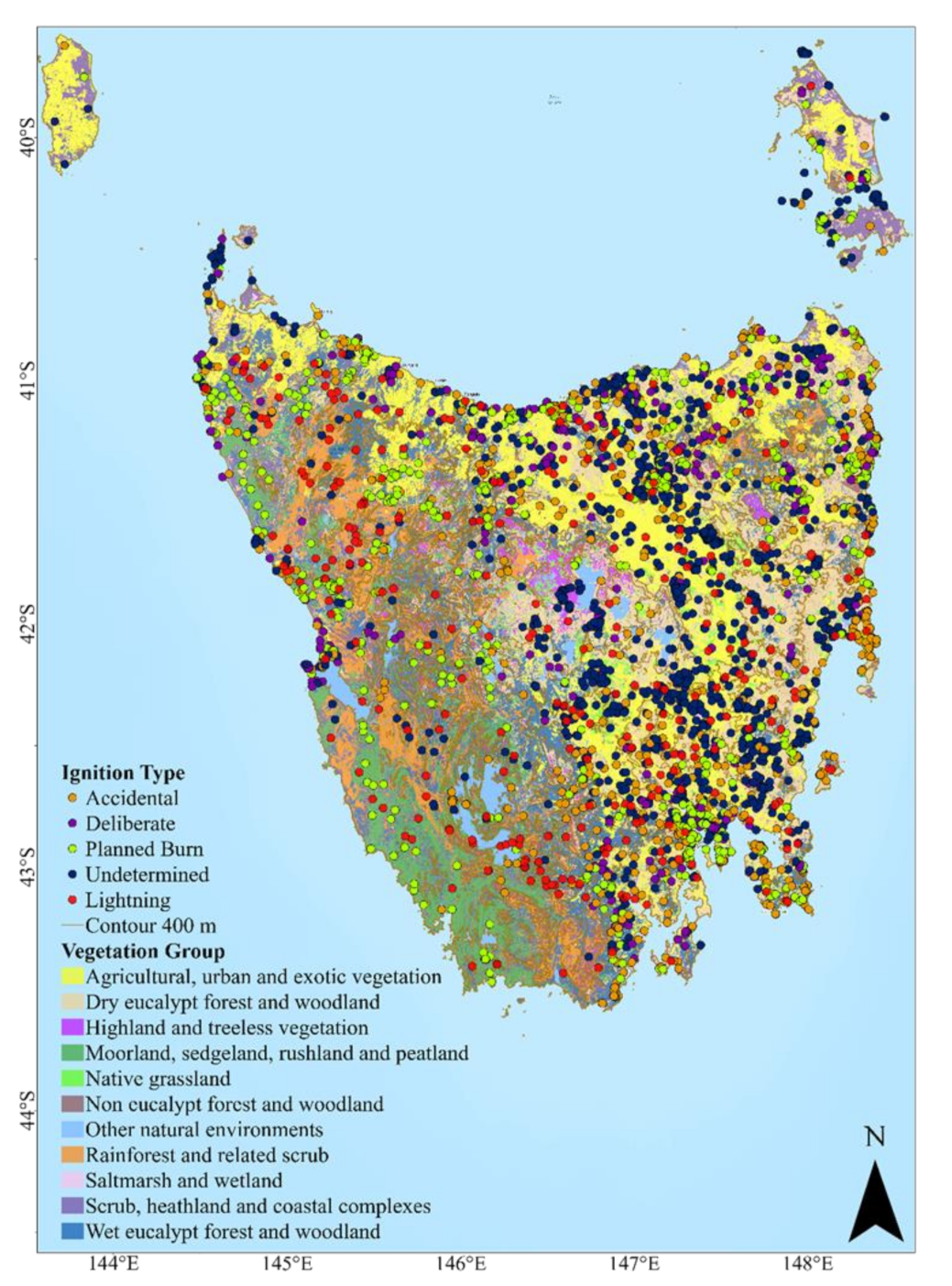
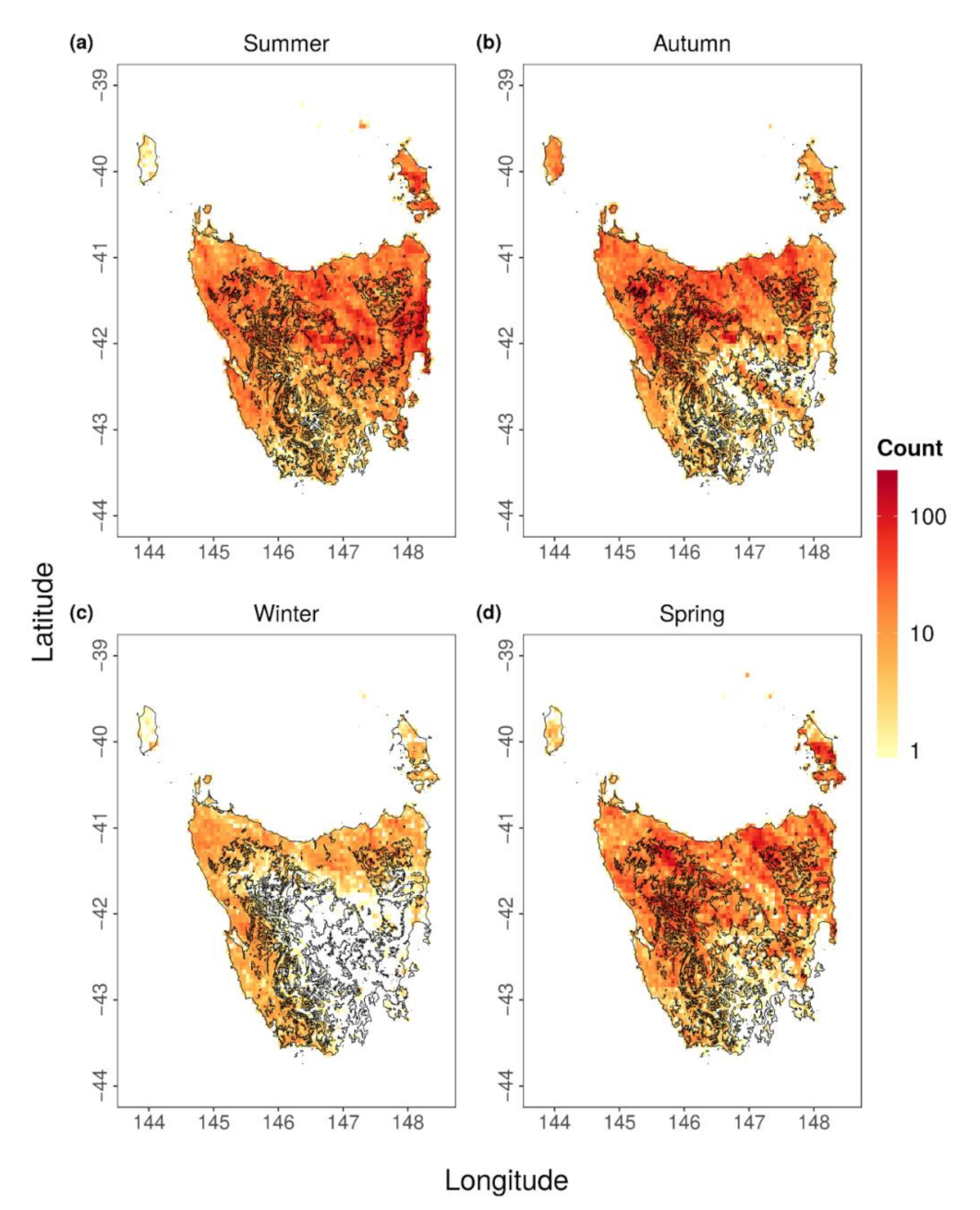
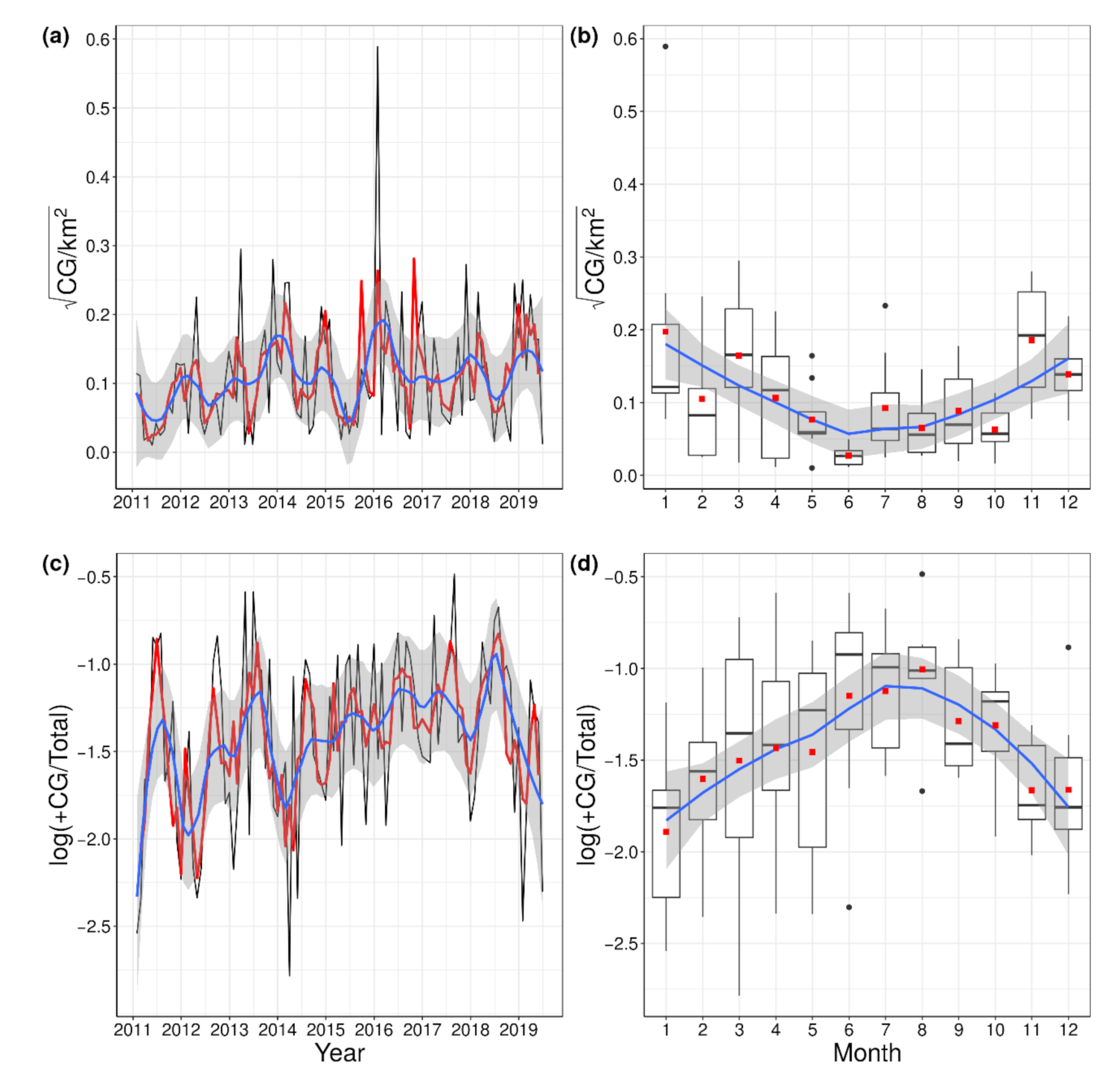
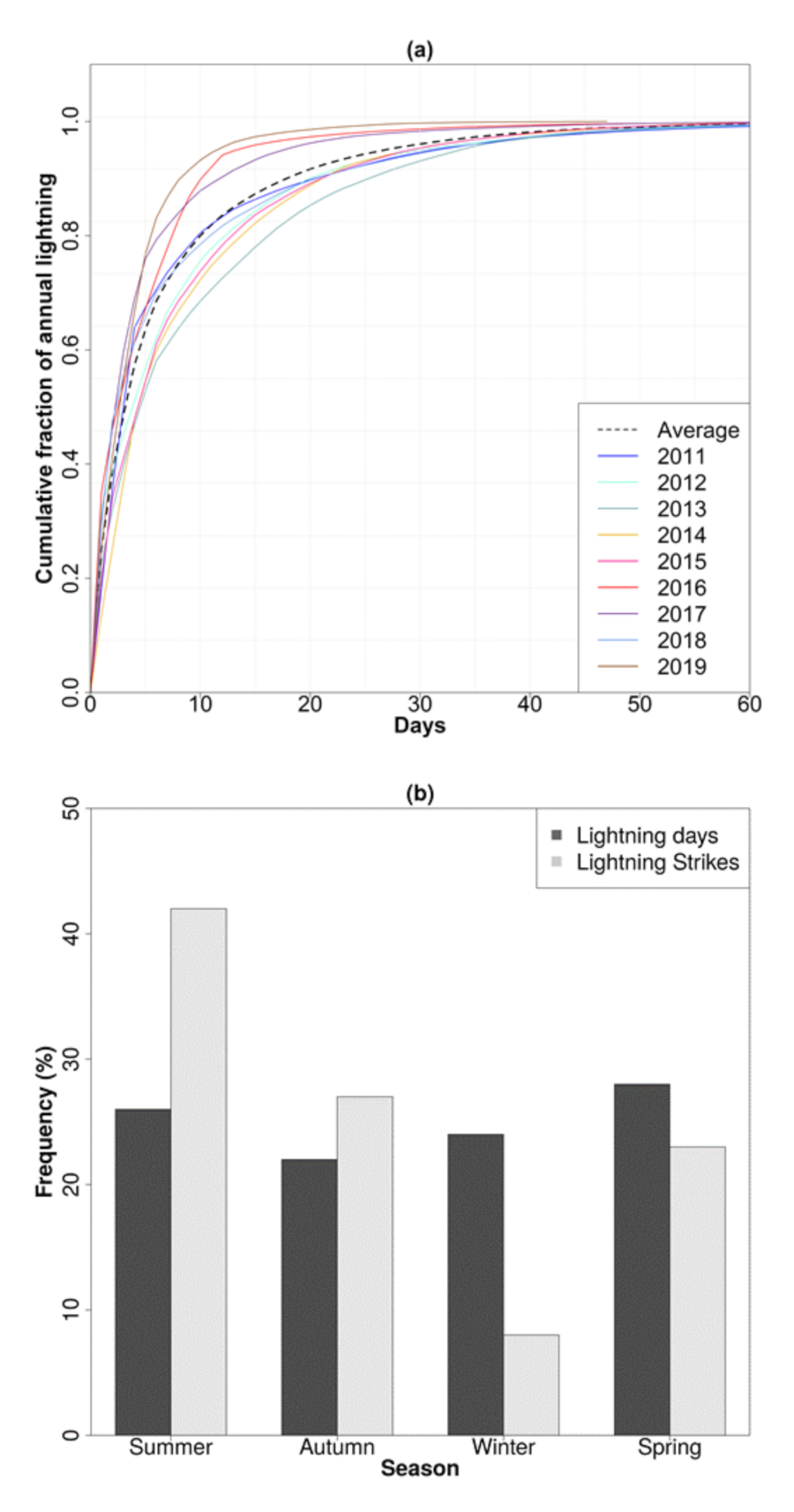
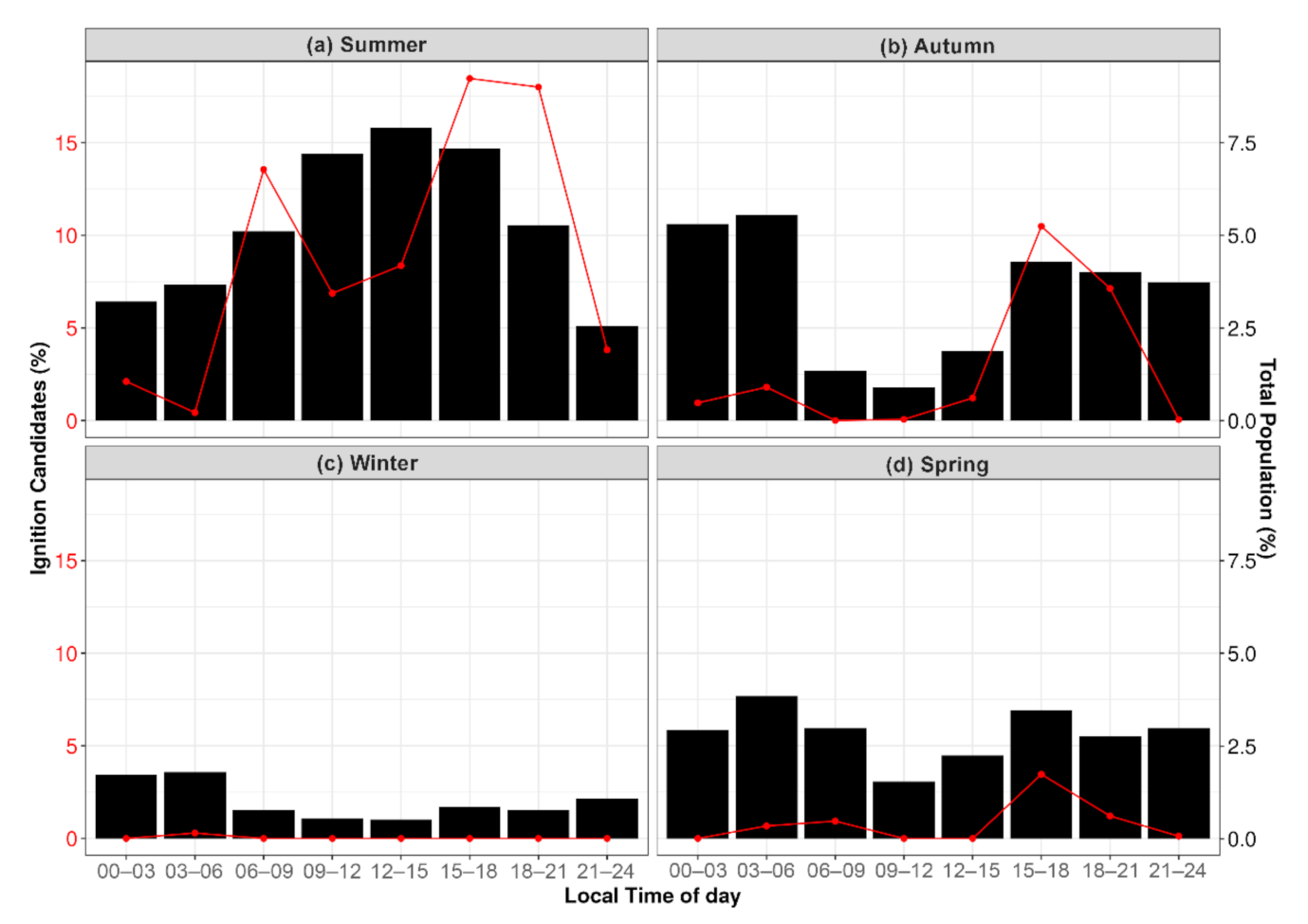
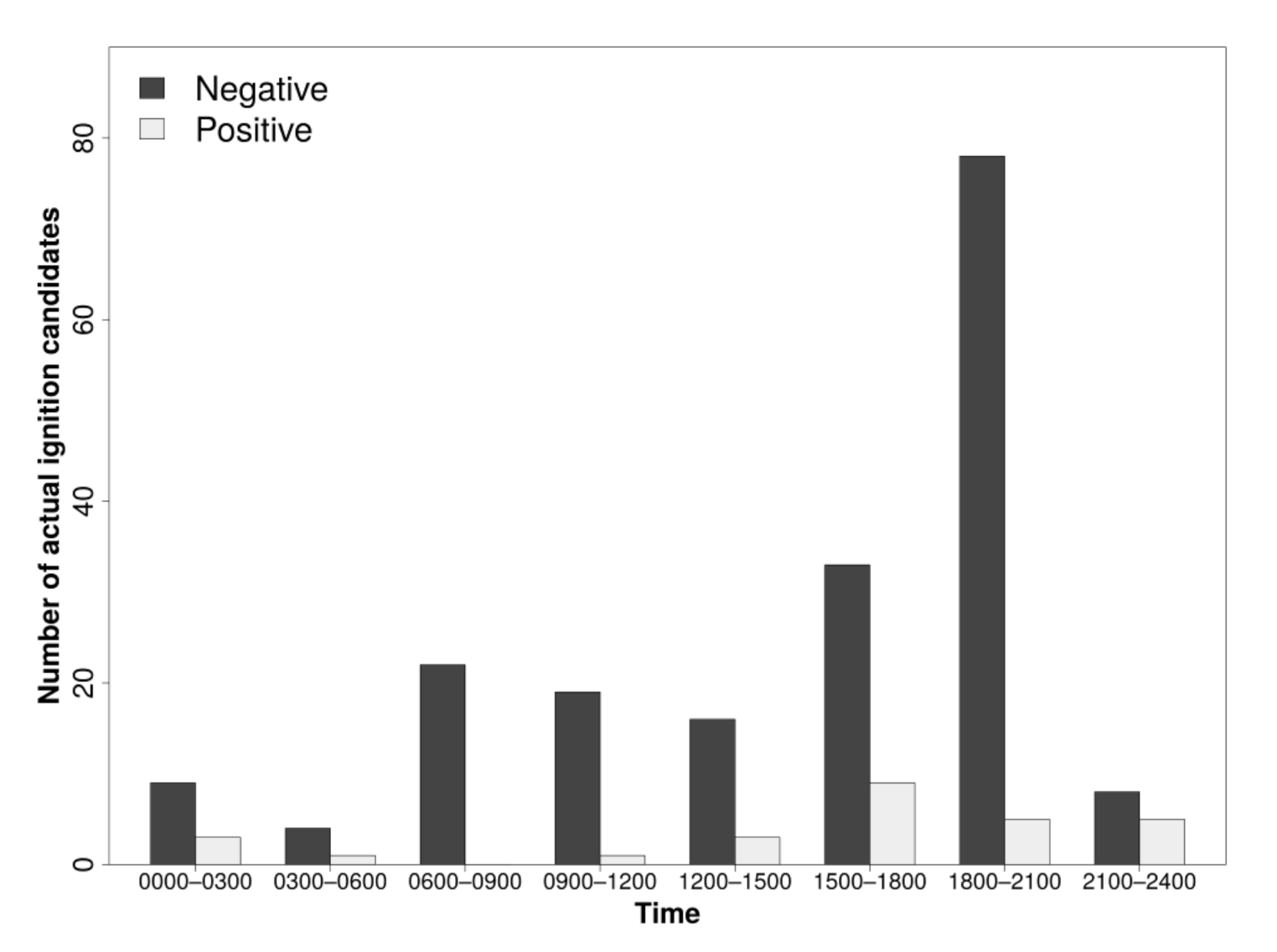
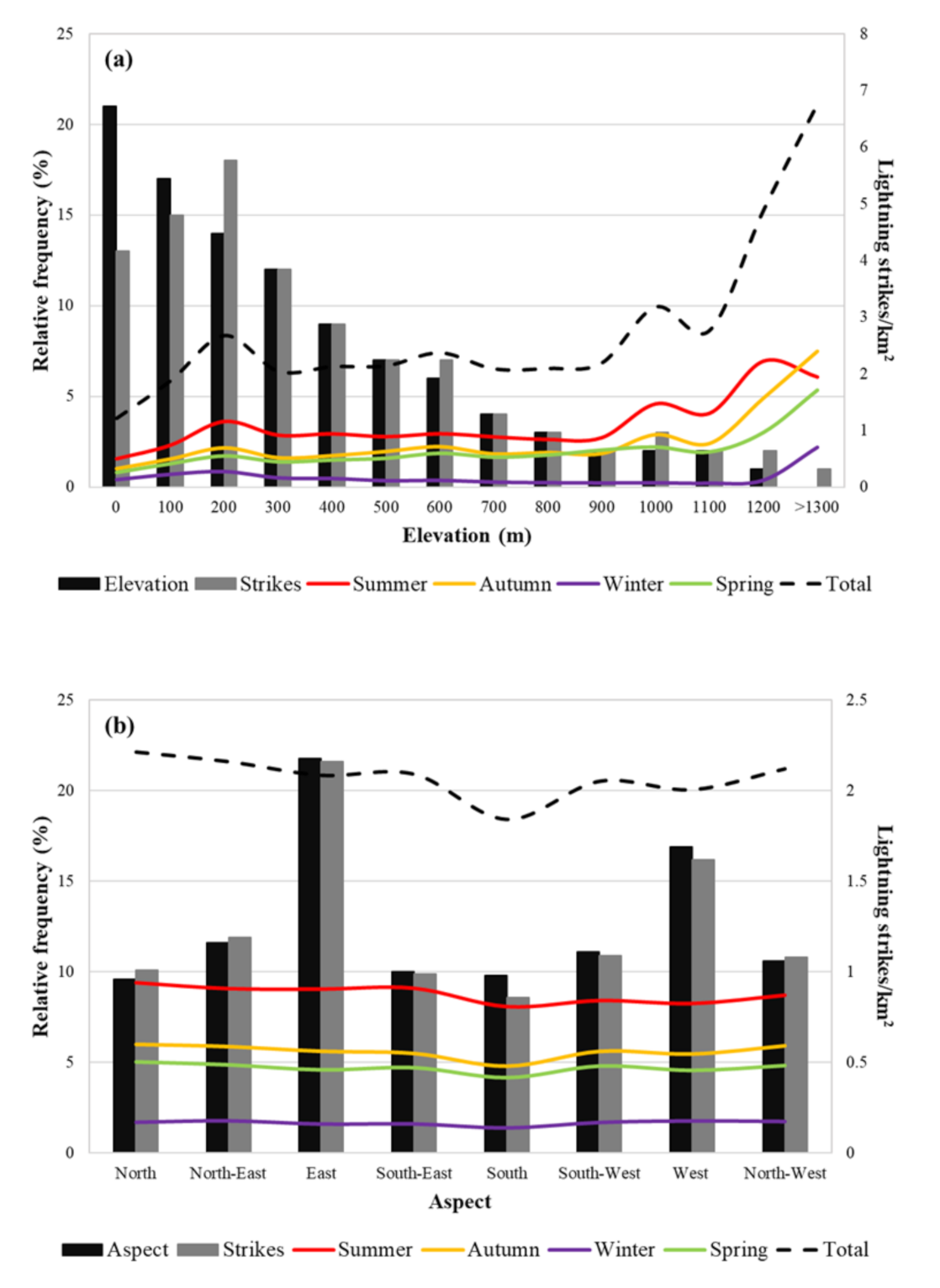
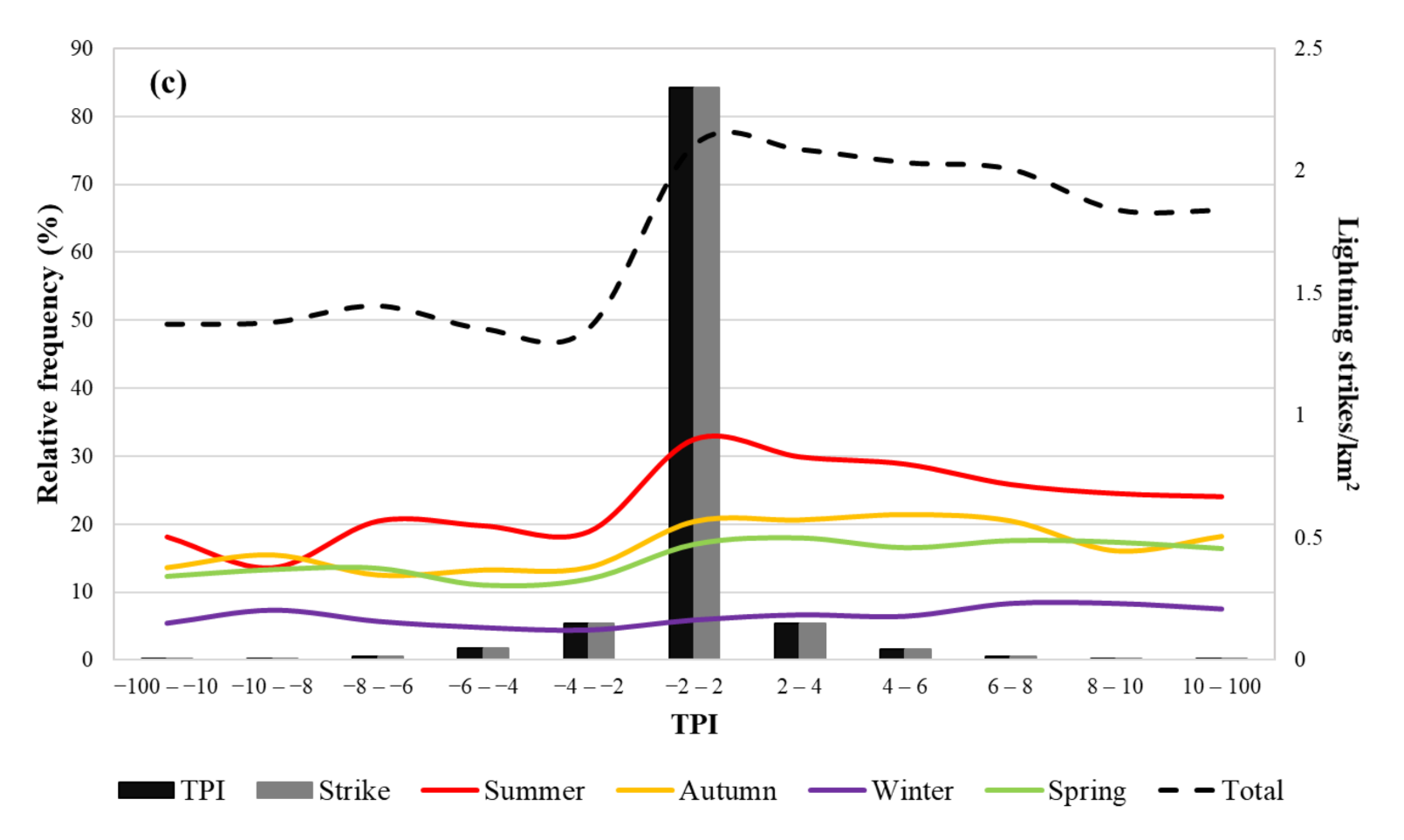
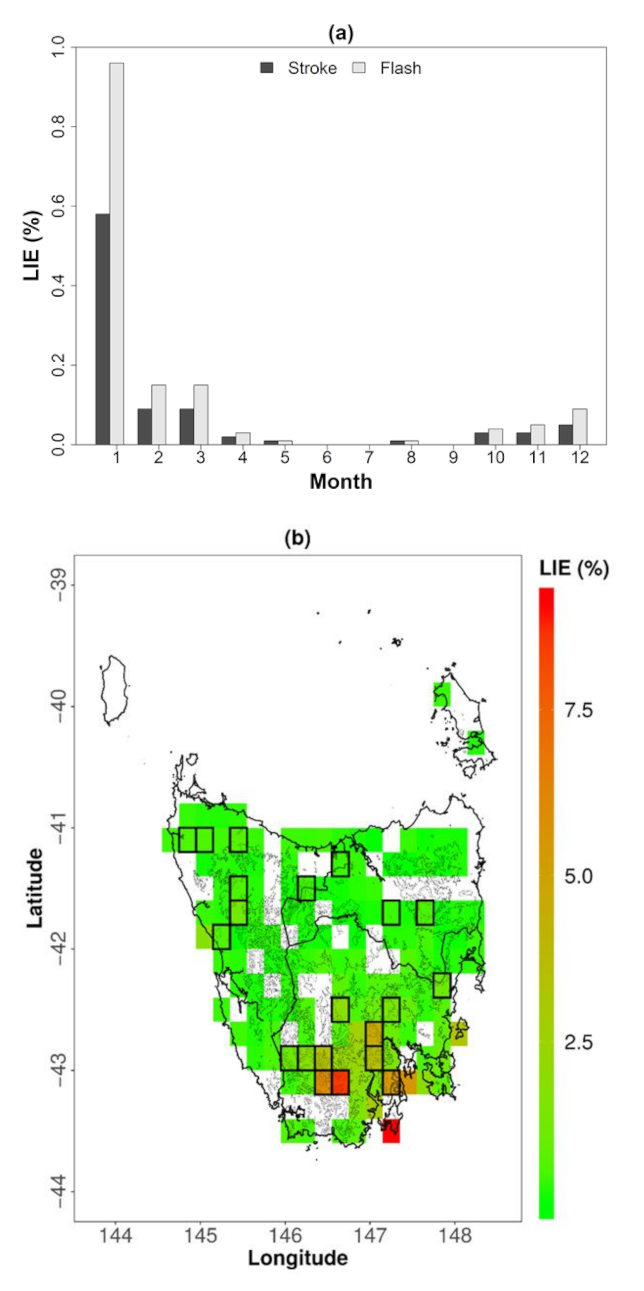
| Total Population | Potential Ignition Candidate Population | |||||||||||||
|---|---|---|---|---|---|---|---|---|---|---|---|---|---|---|
| Lightning Days | Lightning Strikes | Lightning Days | Lightning Strikes | |||||||||||
| Year | − | + | Total | − | + | Total | (−:+) | − | + | Total | − | + | Total | (−:+) |
| 2011 | 82 | 60 | 89 | 4160 | 649 | 4809 | 87:13 | 2 | 1 | 2 | 17 | 8 | 25 | 68:32 |
| 2012 | 82 | 66 | 89 | 7534 | 1384 | 8918 | 84:16 | 4 | 3 | 4 | 95 | 6 | 101 | 94:6 |
| 2013 | 88 | 75 | 93 | 14,271 | 4026 | 18,297 | 78:22 | 6 | 4 | 6 | 1102 | 375 | 1477 | 75:25 |
| 2014 | 74 | 66 | 78 | 14,369 | 3298 | 17,667 | 81:19 | 11 | 7 | 11 | 732 | 152 | 884 | 83:17 |
| 2015 | 70 | 55 | 73 | 4676 | 1880 | 6556 | 71:29 | 1 | 2 | 3 | 19 | 9 | 28 | 68:32 |
| 2016 | 78 | 75 | 89 | 31,190 | 8881 | 40,071 | 78:22 | 6 | 6 | 6 | 2176 | 387 | 2563 | 85:15 |
| 2017 | 66 | 60 | 74 | 7868 | 3314 | 11,182 | 70:30 | 4 | 3 | 4 | 467 | 360 | 827 | 56:44 |
| 2018 | 83 | 78 | 91 | 10,295 | 3504 | 13,799 | 75:25 | 7 | 6 | 8 | 187 | 21 | 208 | 90:10 |
| 2019 | 40 | 40 | 47 | 9741 | 2702 | 12,443 | 78:22 | 7 | 5 | 6 | 1839 | 76 | 1915 | 96:4 |
| Sum | 663 | 575 | 723 | 104,104 | 29,638 | 133,742 | 48 | 37 | 49 | 6634 | 1394 | 8028 | ||
| Avg | 74 | 64 | 80 | 11,567 | 3293 | 14,860 | 78:22 | 5 | 4 | 5 | 737 | 155 | 892 | 83:17 |
| STD | 14 | 11 | 14 | 7728 | 2231 | 9894 | 3 | 2 | 3 | 763 | 161 | 868 | ||
| Population | (%) Single Stroke | (%) Polarity | kA Median (Average) | Average Multiplicity |
|---|---|---|---|---|
| Total (−) | 44 | 73 | 21 (27.3) | 1.58 |
| Total (+) | 67 | 27 | 16.4 (24) | 1.22 |
| PIC (−) | 32 | 76 | 19.75 (23.8) | 1.85 |
| PIC (+) | 63 | 24 | 8.5 (12.15) | 1.25 |
| AIC (−) | 46 | 85 | 27.85 (33.5) | 1.5 |
| AIC (+) | 70 | 15 | 33 (37) | 1.2 |
| Vegetation Type | Area (km2) | Lightning Strikes | Ignitions | LIE (%) |
|---|---|---|---|---|
| Moorland, sedgeland, rushland and peatland | 1365 | 9539 | 37 | 0.39 |
| Native grassland | 2145 | 2495 | 7 | 0.28 |
| Rainforest and related scrub | 5993 | 14,549 | 39 | 0.27 |
| Wet eucalypt forest and woodland | 1084 | 18,107 | 47 | 0.26 |
| Non-eucalypt forest and woodland | 7158 | 4304 | 11 | 0.26 |
| Dry eucalypt forest and woodland | 5133 | 32,739 | 80 | 0.24 |
| Agricultural, urban and exotic vegetation | 10,934 | 34,300 | 71 | 0.21 |
| Scrub, heathland and coastal complexes | 15,894 | 10,509 | 20 | 0.19 |
| Highland and treeless vegetation | 16,240 | 2983 | 2 | 0.07 |
| Other natural environments | 2447 | 3715 | 1 | 0.03 |
| Saltmarsh and wetland | 237 | 461 | 0 | 0.00 |
Publisher’s Note: MDPI stays neutral with regard to jurisdictional claims in published maps and institutional affiliations. |
© 2021 by the authors. Licensee MDPI, Basel, Switzerland. This article is an open access article distributed under the terms and conditions of the Creative Commons Attribution (CC BY) license (http://creativecommons.org/licenses/by/4.0/).
Share and Cite
Nampak, H.; Love, P.; Fox-Hughes, P.; Watson, C.; Aryal, J.; Harris, R.M.B. Characterizing Spatial and Temporal Variability of Lightning Activity Associated with Wildfire over Tasmania, Australia. Fire 2021, 4, 10. https://doi.org/10.3390/fire4010010
Nampak H, Love P, Fox-Hughes P, Watson C, Aryal J, Harris RMB. Characterizing Spatial and Temporal Variability of Lightning Activity Associated with Wildfire over Tasmania, Australia. Fire. 2021; 4(1):10. https://doi.org/10.3390/fire4010010
Chicago/Turabian StyleNampak, Haleh, Peter Love, Paul Fox-Hughes, Christopher Watson, Jagannath Aryal, and Rebecca M. B. Harris. 2021. "Characterizing Spatial and Temporal Variability of Lightning Activity Associated with Wildfire over Tasmania, Australia" Fire 4, no. 1: 10. https://doi.org/10.3390/fire4010010
APA StyleNampak, H., Love, P., Fox-Hughes, P., Watson, C., Aryal, J., & Harris, R. M. B. (2021). Characterizing Spatial and Temporal Variability of Lightning Activity Associated with Wildfire over Tasmania, Australia. Fire, 4(1), 10. https://doi.org/10.3390/fire4010010







